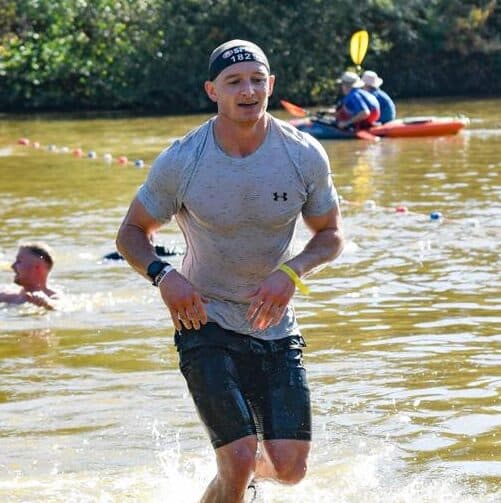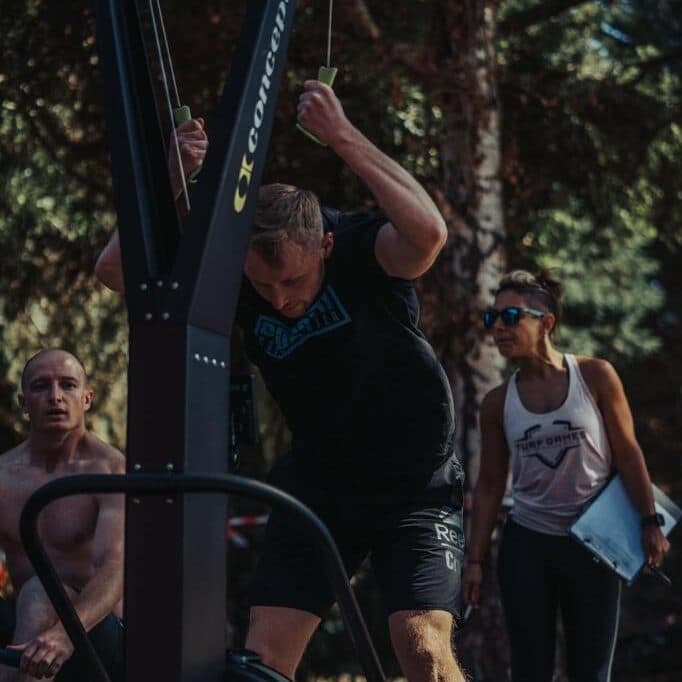OUR 2025/2026 HYROX MEMBERSHIP IS NOW LIVE
Optimising Your Hyrox Sandbag Lunges
Nathan Britten | May 12, 2025 | Hyrox

The sandbag lunges are the penultimate workout station so once you’ve ticked these off that finish line is well and truly just around the corner.
You’ve only got one run left after the lunges so the worry about your legs blowing up begins to subside and you’ll have smashing out a big set on the wall balls in the back of your mind.
In this guide, we’ll cover:
- Movement Rules: Key guidelines for completing the Sandbag Lunge station.
- Technique Cues: How to lunge efficiently and minimize energy waste.
- Common Faults & Best Practices: Mistakes to avoid and how to correct them.
Rules of the Hyrox Sandbag Lunge Station
Let’s look at the rules for the Sandbag Lunge station as there are a few intricacies especially if you are competing in the doubles.
Selecting and Handling the Sandbag
As you enter the lunge station, you will see a pile of sandbags. Make sure to grab the correct sandbag for your division, and remember that you need to return the sandbag to the same spot after completing the lunges. Dropping it carelessly could result in a penalty.
Starting Behind the Line
When beginning your lunges, ensure that your first lunge starts behind the starting line. Throughout the station, alternate legs (left, right, left, right) and ensure that your knee touches the ground with each step.
You’ll likely need to complete 3-4 lengths, and each lunge must finish with a full stand—straightening at the knee and hip between each repetition.

Fitter, Faster, Stronger
One Day at a time
Got a race lined up? Then Race Ready is your for!
Otherwise strengthen your weaknesses each and every day with RoxDaily
7-day free trial | Cancel anytime
Turnaround Points and Penalties
At the end of each length, cross the turnaround line with your entire foot before heading back. You do not need to lunge while turning—there will be a clearly marked space for you to step through.
If you put the sandbag down, penalties apply:
- First drop = 5-meter penalty.
- Second drop = 10-meter penalty.
- Third drop = Disqualification.
In the doubles division, the sandbag must be passed in the air when switching partners. Dropping it during the transition will result in a penalty.
Optimal Sandbag Lunge Technique
Fortunately, the previous station was farmers carry, so you’re legs feel as fried like in other parts of the race.
To be efficient and minimize energy waste during Sandbag Lunges, focus on these key technique points.
1. Maintain a Stacked Position
The key to efficient lunging is keeping your trailing knee (the one behind you) directly underneath your hips. This keeps your body in a stacked position and allows the sandbag to stay close to your centre of gravity, reducing strain on your lower back and legs.
2. Distribute Weight Evenly
Ensure that both your front and back legs are sharing the load. You want an equal amount of stress through your quads, hamstrings, and glutes, allowing the movement to be more efficient. Avoid leaning too far forward, which places unnecessary strain on your lower back.
3. Keep Your Chest Proud
A key part of maintaining good posture is keeping your chest up and your eyes forward. By looking at the end of your lane (or the horizon), you avoid rounding your shoulders or collapsing your chest forward, which can lead to energy leakage and increased lower back strain.
4. Relax Your Arms
Once the sandbag is secure on your shoulders, try to relax your arms as much as possible. Allow the sandbag to sit naturally on your shoulders.
You should be so relaxed that you can let go of one of the handles and let your arm drop by your side. This helps you conserve energy in your shoulders, saving it for later stages of the race.
Common Mistakes and How to Fix Them
When you are tired it is easy to fall into bad habits with lunges. With it being so late in the race you’ll be doing the lunges under fatigue so let’s look at some common mistakes and how to fix them.
1. Taking Narrow Steps
One common error is taking narrow steps, which can throw off your balance and force you to use more energy to stabilize yourself. This is similar to walking on a tightrope, making the movement less efficient.
- Fix: Take wider steps, keeping your feet just outside your hips. This wider base of support will help maintain balance and allow for smoother lunges.
2. Overstriding
Overstriding—where your trailing knee ends up behind your hips—forces you to lean forward and puts extra strain on your back and hamstrings. While it may give you slightly more distance per step, it’s inefficient for the entire station.
- Fix: Keep your knee underneath your hips to ensure a strong, stacked position. If necessary, save overstriding for the very end of a length, when a few big lunges could help you finish faster.
3. Tense Arms
Athletes often grip the sandbag handles too tightly, which leads to wasted energy and unnecessary tension in the shoulders and arms.
- Fix: Relax your grip and let the sandbag rest on your shoulders. If possible, release one hand and let it hang by your side to relieve shoulder tension.
4. Looking Down
When athletes get tired, they tend to look down at the ground, which often leads to rounded shoulders and poor posture.
- Fix: Keep your eyes forward and your chest proud. This will help you maintain good posture and avoid placing unnecessary strain on your lower back.
Techniques foR Lunges
There are two main approaches to linking your lunges together, depending on your fitness level and how fast you want to move through the station.
1. Step-Through Technique
The step-through technique involves bringing your feet together after each lunge, pausing briefly before the next step. This controlled cadence helps you regulate your breathing and lower your heart rate, making it a good choice for pacing yourself.
2. Swoop-Through Technique
For more advanced athletes, the swoop-through technique allows you to move faster by letting your rear leg swing through into the next lunge without pausing. This technique requires a strong form, as you still need to fully extend your knee and hip with each step.
- Pro Tip: The swoop-through is quicker but more taxing on your cardiovascular system. Only use it if you can maintain form and handle the higher energy output.
Tips for Doubles Transitions
In the doubles division, transitioning the sandbag between partners is crucial for maintaining speed and avoiding penalties. Here are two methods:
1. Overhead Press Transfer
When it’s time to swap, the outgoing partner grabs the handles of the sandbag and presses it over their head for the incoming partner to grab. This technique is fast but requires good shoulder strength.
2. Turnaround Transfer
For athletes who are fatigued or find the overhead press too difficult, the turnaround method allows the outgoing partner to rotate and let the bag fall onto the incoming partner’s shoulders. This is slower but requires less upper-body strength.
Final Tips for Sandbag Lunge Success
- Pace Yourself: Sandbag Lunges come late in the race, so pace yourself carefully. Avoid starting too fast and burning out early.
- Practice Transitions: If you’re in the doubles division, practice smooth, efficient transitions with your partner. Time your switches to avoid penalties.
- Train Leg Endurance: Since you cannot put the sandbag down without penalty, make sure your leg endurance is up to par so you can complete the station without dropping the bag.
By refining your technique and avoiding common faults, you’ll be able to move through the Sandbag Lunge station more efficiently, conserving energy for the final push in your race.
Related Posts
Our Tools
Leave nothing to Chance!
Our tools review your performances, optimise your training and strategise your races
Didn't Find what you're looking for?
Drop us a message on WhatsApp or ping us an email. We usually reply within the hour.



























